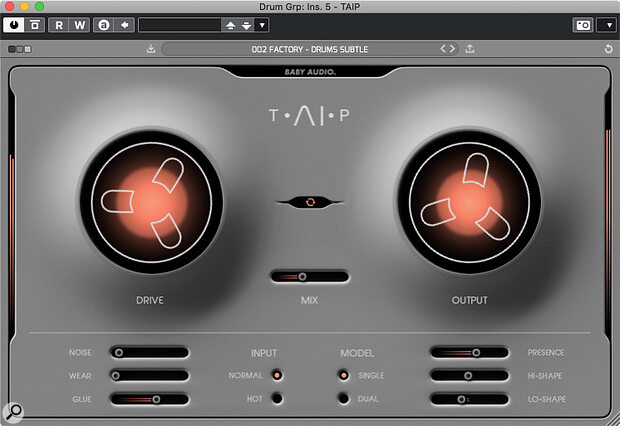Ever wondered what AI technology might bring to the tape‑emulation party?
Baby Audio may be relatively young in plug‑in developer terms but over the last couple of years they’ve grown an impressive collection of modestly priced plug‑ins that have earned some very positive reviews. The latest addition to the catalogue is TAIP, pronounced ‘tape’. Yes, it’s another tape emulation plug‑in — but the twist in the spelling denotes the involvement of some AI in the underlying algorithm, so there’s a little more going on here than with most. Is TAIP worth the price of entry? Let’s find out...
The UI follows the modern, minimalist styling of Baby Audio’s other plug‑ins: TAIP is built around a single screen with a simple preset browser system, a handful of controls, and the option to toggle between three colour schemes. The purpose of some controls is perhaps more obvious than others. For example, Drive controls the input level, letting you go from subtle to obviously overdriven, and a useful Auto Gain button ensures a consistent output level as you increase the Drive. The Hot option lets you add more distortion, while the Mix control lets you apply your tape effect as a parallel process. The latter is linked to the Wear control, which allows you to dial in a tape flanging effect.
The Hi/Lo‑Shape sliders give you some control over the tonal emphasis of any saturation and, with the Presence slider, allow you to tailor the effect’s coloration in some very useful ways, to suit different sources. If required, you can also degrade your signal using the Noise and Wear controls, as well as switch between Single and Dual tape emulations; the effect of this is more apparent at higher Drive settings.
Perhaps most interesting, though, is the Glue control. Tape emulation is often talked about in terms of its ability to ‘glue’ together a mix so that it feels more cohesive, and this is due in large part to the compression that tape naturally applies. Glue lets you add that characteristic to taste, and it’s quite addictive, especially when used with more subtle Drive settings.
With an intuitive, streamlined control set, it really doesn’t take long to dial things in yourself.
Having tried TAIP with a range of audio sources (including a drum bus, electric bass, overdriven guitars, vocals and a full mix bus), I’ve been suitably impressed by what it can do. The preset collection provides excellent starting points in all sorts of contexts but, with an intuitive, streamlined control set, it really doesn’t take long to dial things in yourself. As with almost all harmonic distortion‑style processors, TAIP can very quickly suck you in to believing ‘more is better’, and while you’ll sometimes deliberately want to go OTT to crush a sound for effect, you do need to watch out for that trap. With a little user discretion, though, the results can be very good indeed, and it can do wonders if you need to give a drum bus a lift.
There are lots of tape and saturation plug‑ins around now, and TAIP’s competitors cover a broad spectrum of options, spanning something like the subtlety of Slate’s excellent Virtual Tape Machine to plug‑ins that can deliver more obvious effects, such as Black Box’s impressive HG2. TAIP can certainly cater for the subtle end of that range but, for me at least, it was most impressive when taken that touch further, so that the results were more obvious. Used in this way, it’s a magnificently simple means of making almost any source sound bigger and better. It is also competitively priced, addictive and easy to use: TAIP’s free trial is well worth taking for a spin.
Summary
TAIP is a worthy addition to the Baby Audio catalogue. A very cool ‘make it better’ plug‑in that’s both easy in use and on the pocket.

